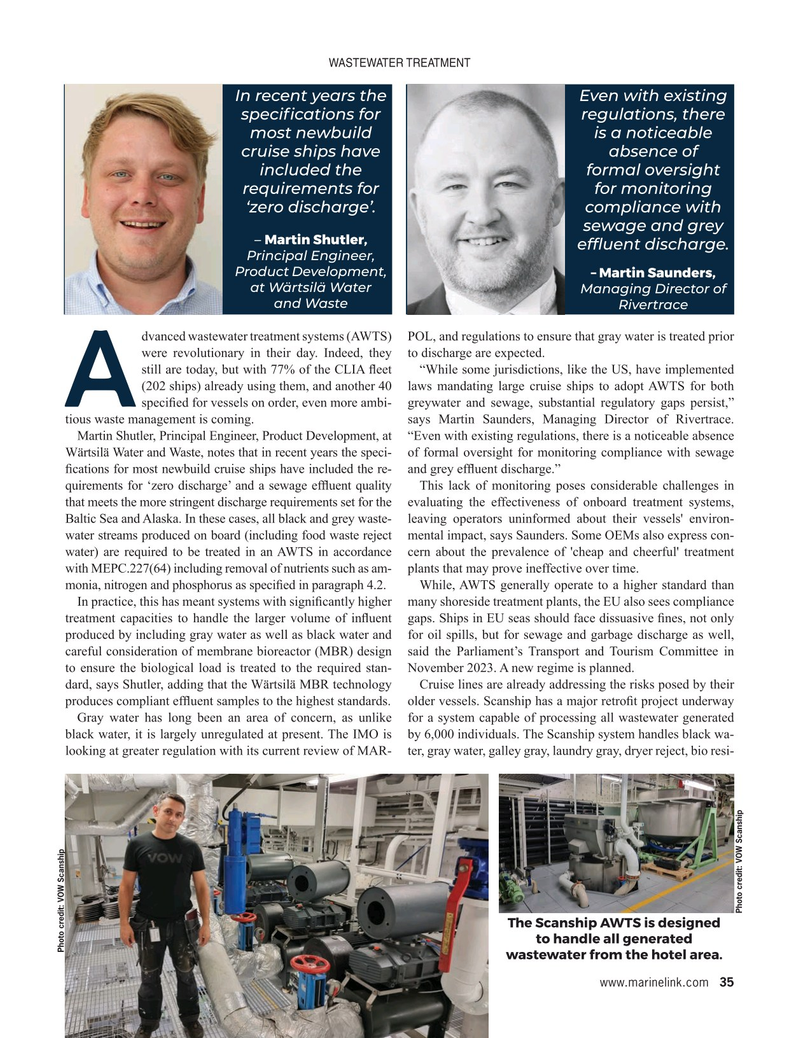
Page 35: of Maritime Reporter Magazine (January 2024)
Read this page in Pdf, Flash or Html5 edition of January 2024 Maritime Reporter Magazine
WASTEWATER TREATMENT
In recent years the Even with existing speci? cations for regulations, there most newbuild is a noticeable cruise ships have absence of included the formal oversight requirements for for monitoring ‘zero discharge’. compliance with sewage and grey – Martin Shutler, ef? uent discharge.
Principal Engineer,
Product Development, – Martin Saunders, at Wärtsilä Water Managing Director of and Waste Rivertrace dvanced wastewater treatment systems (AWTS) POL, and regulations to ensure that gray water is treated prior were revolutionary in their day. Indeed, they to discharge are expected. still are today, but with 77% of the CLIA ? eet “While some jurisdictions, like the US, have implemented (202 ships) already using them, and another 40 laws mandating large cruise ships to adopt AWTS for both
A speci? ed for vessels on order, even more ambi- greywater and sewage, substantial regulatory gaps persist,” tious waste management is coming. says Martin Saunders, Managing Director of Rivertrace.
Martin Shutler, Principal Engineer, Product Development, at “Even with existing regulations, there is a noticeable absence
Wärtsilä Water and Waste, notes that in recent years the speci- of formal oversight for monitoring compliance with sewage ? cations for most newbuild cruise ships have included the re- and grey ef? uent discharge.” quirements for ‘zero discharge’ and a sewage ef? uent quality This lack of monitoring poses considerable challenges in that meets the more stringent discharge requirements set for the evaluating the effectiveness of onboard treatment systems,
Baltic Sea and Alaska. In these cases, all black and grey waste- leaving operators uninformed about their vessels' environ- water streams produced on board (including food waste reject mental impact, says Saunders. Some OEMs also express con- water) are required to be treated in an AWTS in accordance cern about the prevalence of 'cheap and cheerful' treatment with MEPC.227(64) including removal of nutrients such as am- plants that may prove ineffective over time.
monia, nitrogen and phosphorus as speci? ed in paragraph 4.2. While, AWTS generally operate to a higher standard than
In practice, this has meant systems with signi? cantly higher many shoreside treatment plants, the EU also sees compliance treatment capacities to handle the larger volume of in? uent gaps. Ships in EU seas should face dissuasive ? nes, not only produced by including gray water as well as black water and for oil spills, but for sewage and garbage discharge as well, careful consideration of membrane bioreactor (MBR) design said the Parliament’s Transport and Tourism Committee in to ensure the biological load is treated to the required stan- November 2023. A new regime is planned.
dard, says Shutler, adding that the Wärtsilä MBR technology Cruise lines are already addressing the risks posed by their produces compliant ef? uent samples to the highest standards. older vessels. Scanship has a major retro? t project underway
Gray water has long been an area of concern, as unlike for a system capable of processing all wastewater generated black water, it is largely unregulated at present. The IMO is by 6,000 individuals. The Scanship system handles black wa- looking at greater regulation with its current review of MAR- ter, gray water, galley gray, laundry gray, dryer reject, bio resi-
Photo credit: VOW Scanship
The Scanship AWTS is designed to handle all generated
Photo credit: VOW Scanship wastewater from the hotel area. www.marinelink.com 35
MR #1 (34-44).indd 35 1/8/2024 9:38:30 AM

 34
34

 36
36
